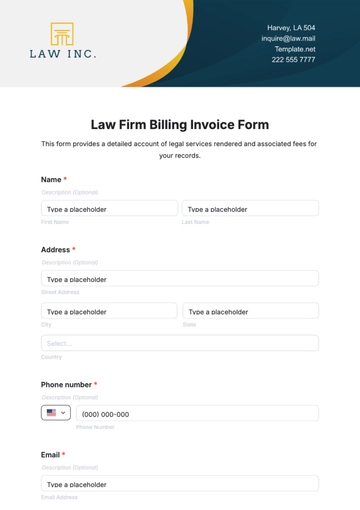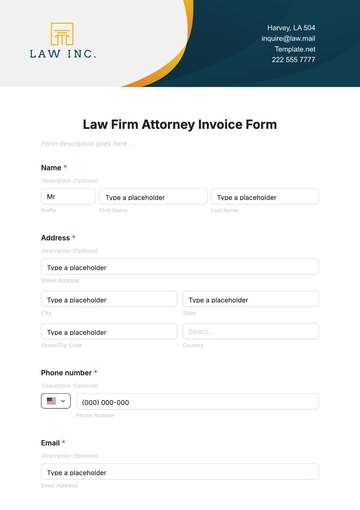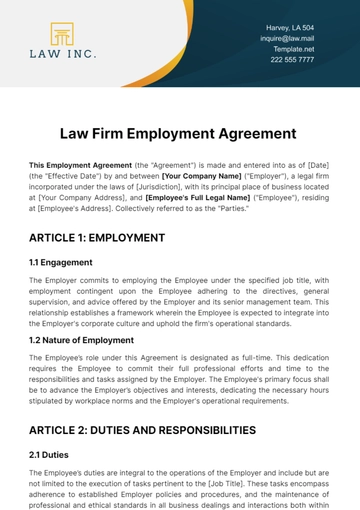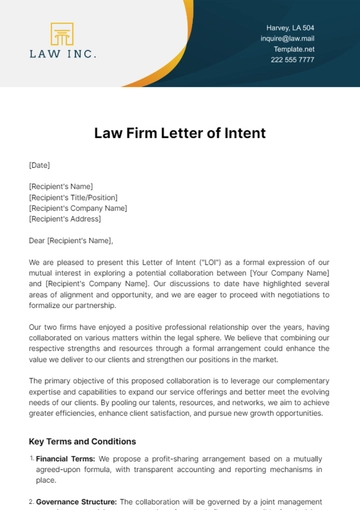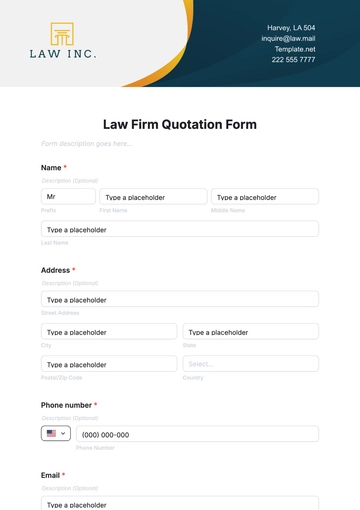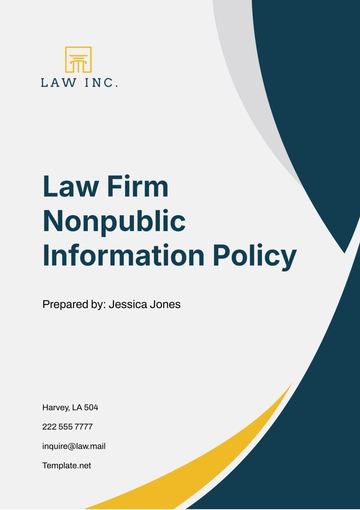Free Law Firm Financial Strategy

I. Executive Summary
The objective of this Law Firm Financial Strategy Plan is to craft a robust framework aimed at bolstering the financial robustness and fostering continuous growth across the practice. This strategy meticulously targets essential aspects including elevating profitability, optimizing cash flow processes, stringent cost control measures, and enhanced financial oversight and analytics. By integrating these elements, we ensure a holistic approach to financial management that is aligned with our long-term goals and agile enough to adapt to evolving market dynamics.
In pursuit of these objectives, our plan introduces innovative financial practices and technologies that streamline operations and improve decision-making. With a focus on data-driven strategies, we aim to enhance revenue streams and identify new growth opportunities, while maintaining rigorous financial discipline.
This approach ensures we not only meet but exceed our performance targets, providing a competitive edge in the increasingly complex legal landscape.
Risk management is a cornerstone of our financial strategy, incorporating comprehensive risk assessments and mitigation plans to safeguard the firm's assets and reputation. By proactively addressing potential financial vulnerabilities and regulatory changes, we maintain stability and confidence among our partners and clients. This strategic foresight is crucial for sustaining profitability and securing the firm’s future in a volatile economic environment.
II. Enhancing Profitability through Effective Pricing Strategies
To fortify our law firm's market position and enhance profitability, this section outlines strategic actions aimed at refining our pricing models. By balancing client satisfaction with financial performance, we adopt a multi-faceted approach. This includes competitive rate benchmarking, tiered pricing, performance-based billing, and continual adjustments driven by client insights and technological advancements in billing accuracy.
Strategy | Description | Expected Outcome |
|---|---|---|
Market Analysis | Conduct comprehensive analysis to compare our billing rates against those of competitors. | Ensure competitive pricing while maintaining market relevance. |
Development of Tiered Pricing Models | Create pricing structures that cater to various client segments, enhancing accessibility. | Increase client base and satisfaction. |
Introduction of Performance-Based Billing | Implement billing options that reward efficiency, aligning costs with client success metrics. | Enhance team productivity and align incentives. |
Regular Review and Adjustment of Billing | Continuously evaluate and refine billing structures based on thorough profitability analysis. | Optimize financial outcomes and client retention rates. |
Technology Solutions for Billing Accuracy | Employ advanced technology to improve time tracking and minimize billing discrepancies. | Reduce operational costs and enhance billing accuracy. |
III. Cost Management and Optimization
In this section, we delineate our strategic measures to elevate the firm’s profitability by implementing rigorous cost management and optimization tactics. These strategies are designed to scrutinize and refine expenditure across various facets of operations, from supplier contracts to office management and technological investments, ensuring maximum efficiency and cost-effectiveness.
Strategy | Description | Expected Outcome |
|---|---|---|
Contract Review and Renegotiation | Systematically review and renegotiate terms with suppliers and vendors to secure more favorable terms. | Reduce procurement costs and improve supply chain terms. |
Centralized Purchasing System | Implement a centralized approach to purchasing to leverage bulk buying and obtain discounts. | Cut down on material costs through strategic procurement. |
Optimization of Office Space | Reevaluate office space utilization and expand remote work options to decrease overhead costs. | Decrease rental and utility expenses. |
Investment in Energy-Efficient Technology | Invest in technologies that enhance energy efficiency, reducing long-term utility overheads. | Lower energy costs and support environmental goals. |
Streamlining Administrative Processes | Automate routine administrative tasks to reduce labor costs and increase operational efficiency. | Minimize administrative expenses and boost productivity. |
Through these targeted strategies, the firm aims to not only reduce costs but also to enhance operational efficiency and sustainability, ultimately driving a more robust bottom line. This proactive approach ensures that our resources are used judiciously while maintaining the high standards of service our clients expect.
IV. Cash Flow Management Enhancement
To sustain liquidity and reinforce operational stability, this section focuses on pivotal strategies for enhancing cash flow management. Each action is strategically crafted to accelerate financial operations and mitigate liquidity risks, ensuring that the firm remains financially agile and prepared to meet both planned and unexpected expenditures effectively.
Action | Impact | Rationale |
|---|---|---|
Implement Electronic Invoicing Systems | Accelerates receivables by reducing processing time. | Enhances the speed and accuracy of billing, improving cash inflow. |
Review Credit Policies | Minimizes credit risk and improves collection rates. | Tightens credit controls to reduce delinquencies and bad debt. |
Optimize Inventory Management | Reduces holding costs and enhances cash reserves. | Minimizes excess stock to free up cash and reduce storage costs. |
Schedule Regular Cash Flow Reviews | Ensures adequate liquidity and financial stability. | Facilitates timely adjustments to financial strategy as needed. |
Establish a Cash Reserve Policy | Provides a buffer against unforeseen financial challenges. | Secures funds to safeguard against volatility and financial shocks. |
Each of these strategies is integral to maintaining a fluid financial operation, essential for the firm's overall health and agility. This proactive approach allows us to manage our resources efficiently, ensuring that we are well-equipped to handle both opportunities and challenges that may arise in our operational landscape.
V. Strengthening Financial Reporting and Analysis
To foster informed decision-making and proactive management, this section articulates our commitment to augmenting our financial reporting and analysis capabilities. By integrating advanced tools and processes, we ensure that our financial data not only reflects real-time insights but also drives strategic actions across the firm, enhancing transparency and accountability.
Action | Impact | Rationale |
|---|---|---|
Adopt Advanced Analytics Tools | Provides deeper insights into financial data. | Empowers the firm with data-driven decision-making capabilities. |
Develop Customized Financial Dashboards | Enables real-time monitoring of financial status. | Offers immediate access to financial metrics, enhancing responsiveness. |
Train Staff on Financial Reporting | Ensures the importance of accurate data entry and timely reporting. | Increases the reliability and accuracy of financial reports. |
Schedule Quarterly Financial Reviews | Facilitates meetings with department heads to review financials. | Promotes regular scrutiny and alignment of departmental budgets with firm goals. |
Regular Updates to Partners | Keeps the firm’s partners informed on financial performance. | Maintains ongoing transparency and alignment with the firm's strategic goals. |
Through these strategic enhancements in financial reporting and analysis, we not only streamline our operations but also position ourselves to swiftly adapt to market changes and internal dynamics, ensuring sustained growth and financial health. This robust framework supports a culture of continuous improvement and strategic foresight within the firm.
VI. Risk Management Framework
Identifying and mitigating financial risks is crucial for the security and sustainability of the firm. This section underscores the strategic initiatives aimed at fortifying our risk management framework. Through comprehensive policies, regular assessments, and stringent controls, we ensure robust defense mechanisms against potential financial disruptions, thereby safeguarding our firm's integrity and continuity.
Action | Impact | Rationale |
|---|---|---|
Develop a Comprehensive Risk Management Policy | Establishes guidelines specific to the firm’s operations. | Creates a standardized approach to managing financial risks tailored to our specific needs. |
Conduct Regular Risk Assessments | Identifies new and emerging risks. | Keeps the firm proactive in recognizing and mitigating evolving threats. |
Implement Strong Internal Controls | Mitigates financial fraud and embezzlement. | Enhances security measures to prevent unauthorized actions and financial discrepancies. |
Train Employees on Compliance | Ensures adherence to ethical financial practices. | Builds a culture of integrity and compliance within the firm. |
Maintain Adequate Insurance Coverage | Protects against significant financial losses. | Provides a financial safety net in the event of substantial losses, ensuring operational stability. |
Through these measures, the firm not only protects itself from potential threats but also builds a foundation of trust and reliability with clients and stakeholders. This risk management framework is integral to maintaining the firm’s reputation and ensuring its long-term success.
VII. Technology Integration and Digitization
Adopting cutting-edge technologies is essential for streamlining operations and enhancing efficiency within the firm. This section details our strategic actions for technology integration and digitization, aiming to transform our operational landscape. Through these initiatives, we leverage technological advancements to optimize processes, improve data security, and foster a culture of innovation.
Action | Impact | Rationale |
|---|---|---|
Implement a Robust ERP System | Centralizes and streamlines business processes. | Enhances operational efficiency and provides integrated data insights across the firm. |
Utilize AI for Predictive Financial Analytics | Employs advanced analytics for financial forecasting. | Improves decision-making with data-driven predictions and trends. |
Upgrade to Cloud-Based Accounting Software | Facilitates accessible, scalable financial management. | Offers real-time financial data access and reduces IT overhead. |
Enhance Cybersecurity Measures | Protects against data breaches and financial data theft. | Secures sensitive financial information and maintains client trust. |
Encourage a Culture of Innovation | Promotes continuous technological advancement within the team. | Fosters an environment where staff are motivated to find and use innovative solutions. |
By integrating these technologies, the firm not only improves its operational capabilities but also secures a competitive edge in the legal market. This forward-thinking approach ensures that we remain at the forefront of industry developments, ready to adapt to changes and embrace new opportunities for growth and efficiency.
VIII. Training and Development
Ensuring the successful implementation of our financial strategy requires continuous training and development of our team. This section highlights the comprehensive training programs designed to enhance our team's capabilities in financial management and leadership. Through targeted training initiatives, we aim to empower our staff with the knowledge and skills needed to excel in their roles and drive the firm’s financial objectives forward.
Training Initiative | Focus Area | Benefits |
|---|---|---|
Regular Training Sessions on Financial Tools | New financial tools and software. | Keeps the team updated on the latest technological advancements and practices. |
Leadership Development Programs | Senior financial managers. | Enhances leadership skills and prepares managers for higher responsibilities. |
Workshops on Financial Best Practices | Best practices and compliance with financial regulations. | Ensures adherence to industry standards and regulatory requirements. |
Performance Reviews | Financial management effectiveness. | Links training outcomes to practical performance improvements. |
Cross-Functional Training | Understanding financial implications across departments. | Promotes holistic understanding of business operations and their financial impacts. |
By investing in these training and development programs, we not only enhance individual competencies but also strengthen our collective ability to meet the firm's strategic financial goals. This commitment to professional growth supports our vision of sustained excellence and adaptability in a dynamic economic landscape.
IX. Performance Monitoring and Adjustment
Continuous monitoring and adjustment are essential to ensure the effectiveness of our financial strategy. This section outlines the systematic approach to tracking performance and making timely adjustments to our strategy, based on real-time data and stakeholder feedback. By implementing these processes, we aim to maintain alignment with our financial goals and adapt swiftly to market changes.
Action | Description | Benefit |
|---|---|---|
Establish Key Performance Indicators | Develop KPIs that are directly aligned with the firm’s financial goals. | Ensures focus on critical metrics that drive financial success. |
Monitor KPIs with Digital Dashboards | Use digital dashboards to track these KPIs in real-time. | Provides immediate insights into financial performance. |
Conduct Bi-Annual Strategy Reviews | Regularly review and adjust the strategy based on performance data. | Keeps the strategy responsive to internal and external shifts. |
Encourage Stakeholder Feedback | Solicit and incorporate feedback from all levels of the organization. | Enhances the strategy with diverse insights and expertise. |
Adapt to Market Changes | Stay responsive to economic shifts and financial trends. | Ensures the firm remains competitive and relevant. |
Through these measures, we ensure that our financial strategy is not only reactive but also proactive, adapting to changes and optimizing performance continuously. This dynamic approach to performance monitoring and adjustment is critical for sustaining growth and achieving long-term financial objectives.
X. Strategic Partnerships and Alliances
Forming strategic partnerships and alliances is crucial for unlocking new growth opportunities and enhancing financial stability. This section elaborates on the actions designed to cultivate and maintain relationships that synergize with our strategic objectives. By strategically aligning with partners, we aim to reduce operational costs, expand market presence, and leverage shared technological platforms for superior service delivery.
Action | Description | Benefit |
|---|---|---|
Identify Potential Partners | Scout for partners whose goals and operations align with our firm. | Ensures alignment of strategic objectives and potential for synergy. |
Negotiate Alliances | Forge partnerships that provide mutual benefits such as cost reduction or access to new markets. | Reduces costs and enhances market reach. |
Collaborate on Technology Platforms | Join forces on technological fronts to enhance service delivery. | Improves operational efficiency and customer satisfaction. |
Promote Joint Marketing Efforts | Coordinate marketing strategies to broaden client base and increase brand visibility. | Expands market presence and reinforces brand recognition. |
Regularly Review Partnership Agreements | Periodically assess and optimize partnerships to ensure they remain aligned with financial goals. | Keeps partnerships productive and aligned with evolving financial objectives. |
Through these strategic actions, the firm not only diversifies its operational capabilities but also secures a stable footing in the competitive market. These partnerships are instrumental in propelling forward our long-term strategic plans and financial ambitions.
XI. Conclusion
This Law Firm Financial Strategy establishes a comprehensive framework designed to fortify profitability, optimize cost management, enhance cash flow, and bolster financial reporting and risk management. By adopting this multifaceted strategy, the firm positions itself to not only meet but exceed its financial goals, ensuring a competitive stance in the dynamic legal market. Our approach integrates advanced technologies and rigorous financial practices that drive efficiency and strategic growth.
Through the diligent implementation of the outlined strategies, from enhancing technological integration to fostering strategic partnerships, the firm is set to improve operational capabilities and financial robustness. These initiatives will enable us to navigate market fluctuations and regulatory changes effectively, maintaining stability and promoting sustainable growth. The plan’s emphasis on continuous training and development ensures our team remains adept and responsive to new challenges.
Moving forward, continuous evaluation and agile adaptation of our financial strategies are imperative to maintaining our market leadership and financial health. By regularly reviewing our financial performance against set benchmarks and adapting to emerging trends and insights, we safeguard our firm’s future. This proactive and strategic approach to financial planning is essential for realizing long-term success and upholding our commitment to excellence and client satisfaction.
- 100% Customizable, free editor
- Access 1 Million+ Templates, photo’s & graphics
- Download or share as a template
- Click and replace photos, graphics, text, backgrounds
- Resize, crop, AI write & more
- Access advanced editor
Harness the power of Template.net's Law Firm Financial Strategy Template to streamline your planning process. This editable template, customizable according to your specific needs, simplifies financial strategy creation and monitoring. Editable in our Ai Editor Tool, it provides an organized structure for efficient financial management. The clarity and precision of this template will propel your law firm's success. Experience the transformative power of structured financial strategy today.














